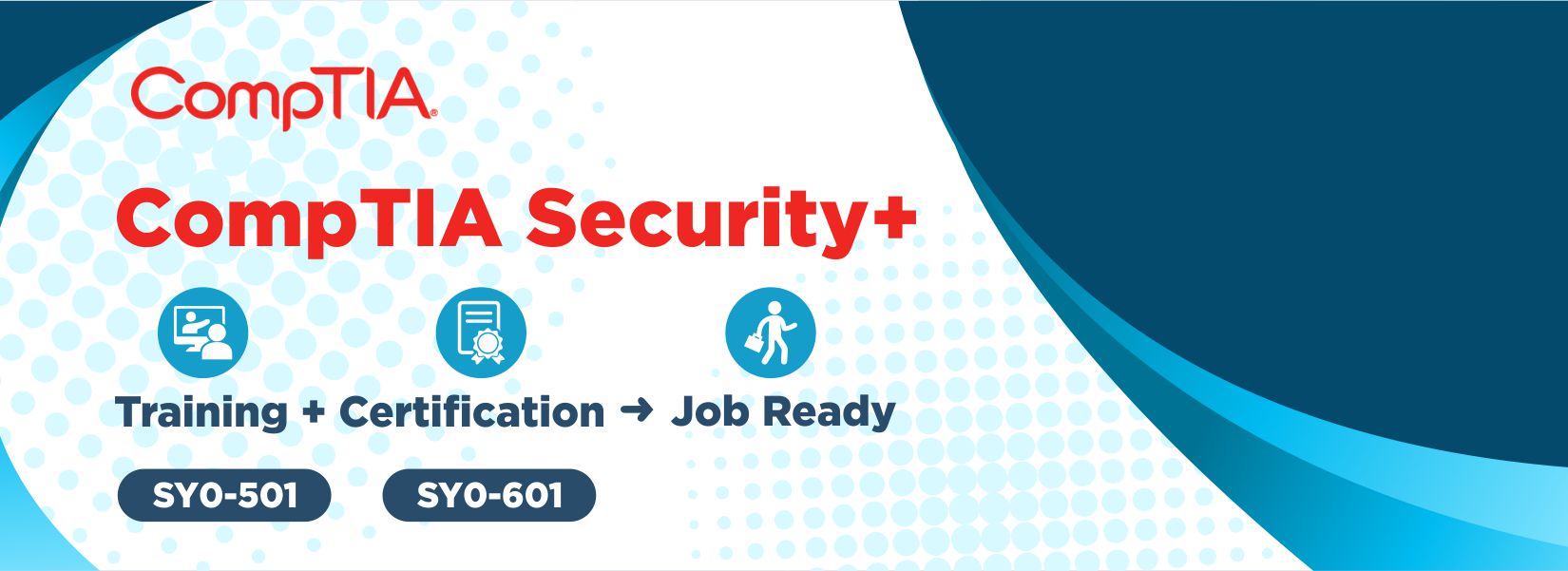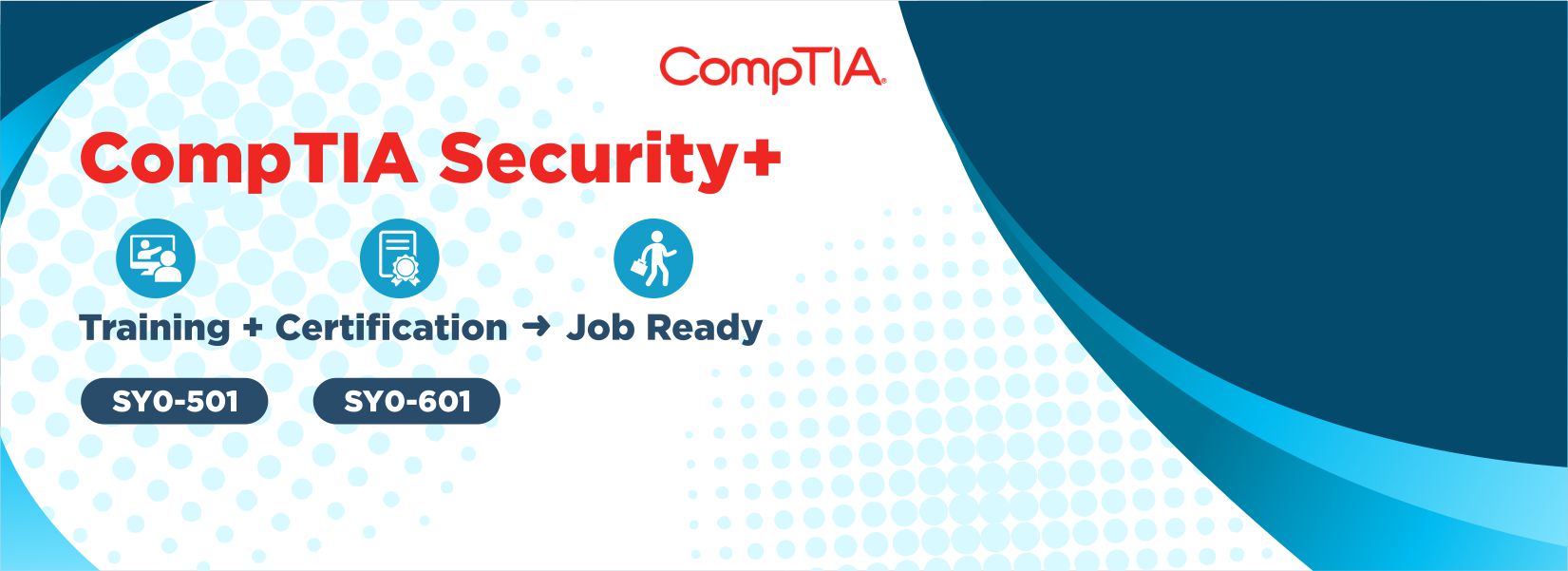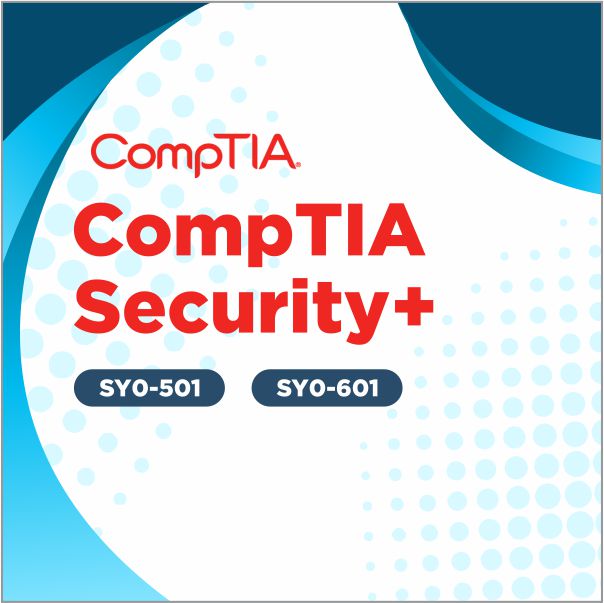CompTIA Security+: SY0-501
The CompTIA Security+ certification is a vendor-neutral credential. The CompTIA Security+ exam is an internationally recognized validation of foundation-level security skills and knowledge, and is used by organizations and security professionals around the globe.
The CompTIA Security+ exam will certify the successful candidate has the knowledge and skills required to install and configure systems to secure applications, networks,and devices;perform threat analysis and respond with appropriate mitigation techniques;participatein risk mitigation activities;andoperate with an awareness of applicable policies, laws, and regulations. The successful candidate will perform these tasks to supportthe principles of confidentiality, integrity,and availability.
The CompTIA Security+ certification is aimed at an IT security professional who has:
- A minimum of two years’experience in ITadministration with a focus on security
- Day-to-day technicalinformation security experience
- Broad knowledge of security concerns and implementation including the topics in the domain list below
Module 1: Threats, Attacksand Vulnerabilities
Types of malware
- Viruses
- Crypto-malware
- Ransomware
- Worm
- Trojan
- Rootkit
- Keylogger
- Adware
- Spyware
- Bots
- Logic bomb
- RAT
- Backdoor
Compare and contrast types of attacks.
- Social engineering
- Application/service attacks
- Wireless attacks
- Cryptographic attacks
Threat actor types and attributes.
- Types of actors
- Attributes of actors
- Use of open-source intelligence
Explain penetration testing concepts.
- Active reconnaissance
- Passive reconnaissance
- Pivot
- Initial exploitation
- Persistence
- Escalation of privilege
- Black box
- White box
- Gray box
- Pen testing vs. vulnerability scanning
Vulnerability scanning concepts.
- Passively test security controls
- Identify vulnerability
- Identify lack of security controls
- Identify common misconfigurations
- Intrusive vs. non-intrusive
- Credentialed vs. non-credentialed
- False positive
The impactassociated with types of vulnerabilities.
- Race conditions
- Vulnerabilities
- Improper input handling
- Improper error handling
- Misconfiguration/weak configuration
- Default configuration
- Resource exhaustion
- Untrained users
- Improperly configured accounts
- Vulnerable business processes
- Weak cipher suites and implementations
- Memory/buffer vulnerability
- System sprawl/undocumented assets
- Architecture/design weaknesses
- New threats/zero day
- Improper certificate and key management
Module 2: Technologies and Tools
Install and configure network components
- Firewall
- VPN concentrator
- NIPS/NIDS
- Router
- Switch
- Proxy
- Load balancer
- Access point
- SIEM
- DLP
- NAC
- Mail gateway
- Bridge
- SSL/TLS accelerators
- SSL decryptors
- Media gateway
- Hardware security module
Use appropriate software toolsto assess the security posture of an organization
- Protocol analyzer
- Network scanners
- Wireless scanners/cracker
- Password cracker
- Vulnerability scanner
- Configuration compliance scanner
- Exploitation frameworks
- Data sanitization tools
- Steganography tools
- Honeypot
- Backup utilities
- Banner grabbing
- Passive vs. active
- Command line tools
Troubleshoot common security issues.
- Unencrypted credentials/clear text
- Logs and eventsanomalies
- Permission issues
- Access violations
- Certificate issues
- Data exfiltration
- Misconfigured devices
- Weak security configurations
- Personnel issues
- Unauthorized software
- Baseline deviation
- License compliance violation(availability/integrity)
- Asset management
- Authentication issues
Analyze and interpret output from securitytechnologies
- HIDS/HIPS
- Antivirus
- File integrity check
- Host-based firewall
- Application whitelisting
- Removable media control
- Advanced malware tools
- Patch management tools
- UTM
- DLP
- Data execution prevention
- Web application firewall
Deploy mobile devices securely.
- Connection methods
- Mobile device management concepts
- Enforcementand monitoring
- Deployment models
Implement secure protocols.
- Protocols
- Use cases
Module 3: Architecture and Design
Explain use cases and purpose for frameworks
- Industry-standard frameworks and reference architectures
- Benchmarks/secure configuration guides
- Defense-in-depth/layered security
Implement secure network architecture concepts.
- Zones/topologies
- Segregation/segmentation/isolation
- Tunneling/VPN
- Security device/technology placement
- SDN
Implement secure systems design.
- Hardware/firmware security
- Operating systems
- Peripherals
Explain the importance of secure staging deployment concepts.
- Sandboxing
- Environment
- Secure baseline
- Integrity measurement
Explain the security implications of embedded systems.
- SCADA/ICS
- Smart devices/IoT
- HVAC
- SoC
- RTOS
- Printers/MFDs
- Camera systems
- Special purpose
Summarize secure application development and deployment concepts.
- Development life-cycle models
- Secure DevOps
- Version control and change management
- Provisioningand deprovisioning
- Secure coding techniques
- Code quality and testing
- Compiled vs. runtime code
Summarize cloud and virtualization concepts
- Hypervisor
- VM sprawl avoidance
- VM escapeprotection
- Cloud storage
- Cloud deployment models
- On-premise vs. hosted vs. cloud
- VDI/VDE
- Cloud access security broker
- Security as a Service
How resiliency and automation strategies reduce risk.
- Automation/scripting
- Templates
- Master image
- Non-persistence
- Elasticity
- Scalability
- Distributive allocation
- Redundancy
- Fault tolerance
- High availability
- RAID
Explain the importance of physical security controls.
- Lighting
- Signs
- Fencing/gate/cage
- Security guards
- Alarms
- Safe
- Secure cabinets/enclosures
- Protected distribution/Protected cabling
- Airgap
- Mantrap
- Faraday cage
- Lock types
- Biometrics
- Barricades/bollards
- Tokens/cards
- Environmental controls
- Cable locks
- Screen filters
- Cameras
- Motion detection
- Logs
- Infrared detection
- Key management
Module 4: Identity and Access Management
Compare and contrast identity and access management concepts.
- Identification, authentication, authorization and accounting (AAA)
- Multifactor authentication
- Federation
- Single sign-on
- Transitive trus
Install and configure identity and access services.
- LDAP
- Kerberos
- TACACS+
- CHAP
- PAP
- MSCHAP
- RADIUS
- SAML
- OpenID Connect
- OAUTH
- Shibboleth
- Secure token
- NTLM
Implement identity and access management controls.
- Access control models
- Physical access control
- Biometricfactors
- Tokens
- Certificate-based authentication
- File system security
- Database security
Differentiatecommon account managementpractices.
- Account types
- General Concepts
- Account policy enforcement
Module 5: Risk Management
Importance of policies.
- Standard operating procedure
- Agreement types
- Personnel management
- General security policies
Summarize business impact analysisconcepts.
- RTO/RPO
- MTBF
- MTTR
- Mission-essential functions
- Identification of critical systems
- Single point of failure
- Impact
- Privacy impact assessment
- Privacy threshold assessment
Risk management processes and concepts.
- Threat assessment
- Risk assessment
- Change management
Follow incident responseprocedures.
- Incident response plan
- Incident response process
Summarizebasic concepts of forensics.
- Order of volatility
- Chain of custody
- Legal hold
- Data acquisition
- Preservation
- Recovery
- Strategicintelligence/counterintelligence gathering
- Track man-hours
Disaster recoveryand continuity of operation concepts.
- Recovery sites
- Order of restoration
- Backup concepts
- Geographic considerations
- Continuity of operationplanning
Compare and contrast various types of controls.
- Deterrent
- Preventive
- Detective
- Corrective
- Compensating
- Technical
- Administrative
- Physical
Carry out data security and privacypractices.
- Data destruction and media sanitization
- Data sensitivity labeling and handling
- Data roles
- Data retention
- Legal and compliance
Module 6: Cryptography and PKI
Compare and contrast basic concepts of cryptography.
- Symmetric algorithms
- Modes of operation
- Asymmetric algorithms
- Hashing
- Salt, IV, nonce
- Elliptic curve
- Weak/deprecated algorithms
- Key exchange
- Digital signatures
- Diffusion
- Confusion
- Collision
- Steganography
- Obfuscation
- Stream vs. block
- Key strength
- Session keys
- Ephemeral key
- Secret algorithm
- Data-in-transit
- Data-at-rest
- Data-in-use
- Random/pseudo-random number generation
- Key stretching
- Implementation vs. algorithm selection
- Perfect forward secrecy
- Security through obscurity
- Common use cases
Cryptography algorithms and their basic characteristics.
- Symmetric algorithms
- Cipher modes
- Asymmetric algorithms
- Hashing algorithms
- Key stretching algorithms
- Obfuscation
Install and configure wireless security settings.
- Cryptographic protocols
- Authentication protocols
- Methods
Implement public key infrastructure.
- Components
- Concepts
- Types of certificates
- Certificate formats





